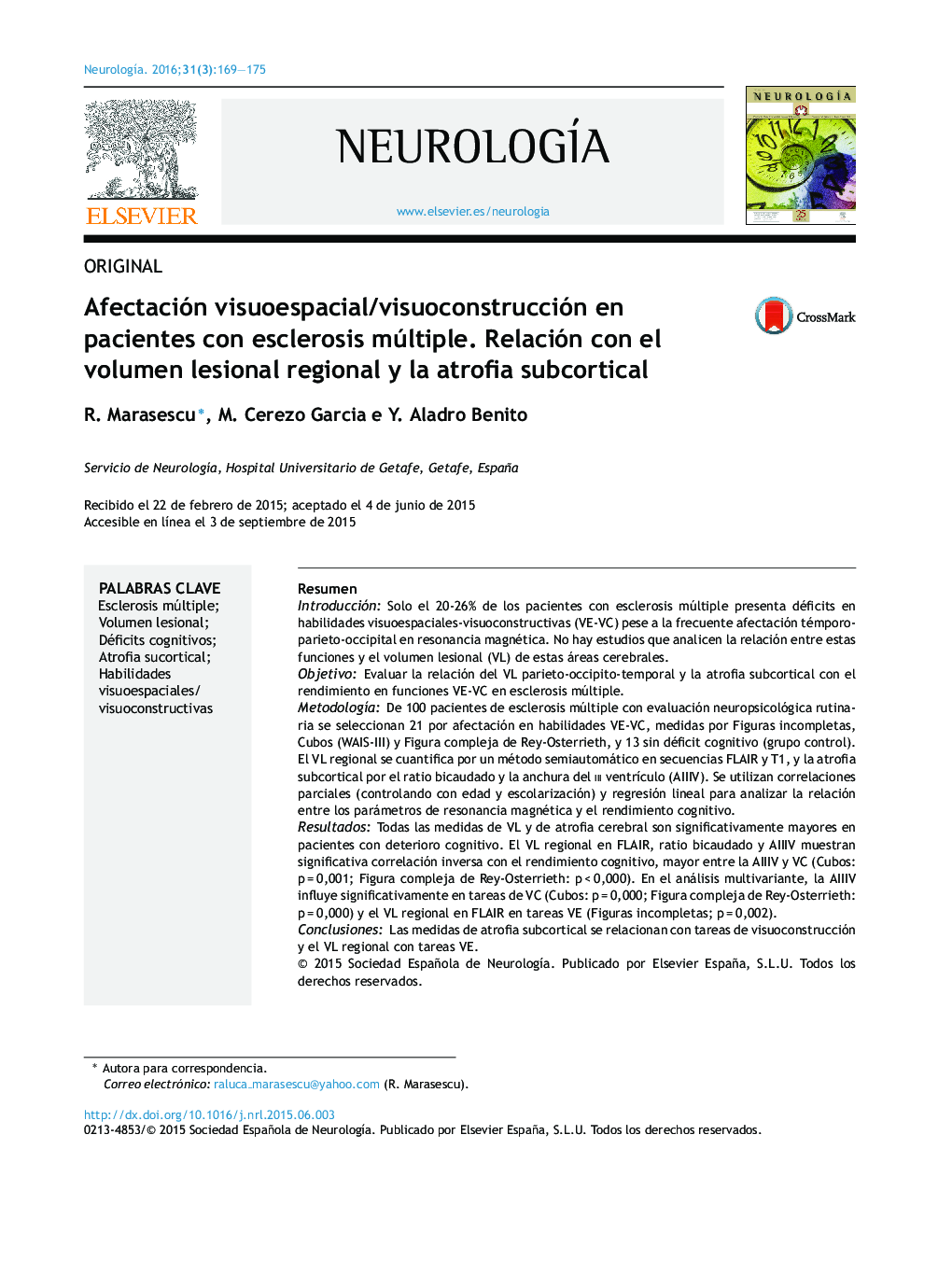| Article ID | Journal | Published Year | Pages | File Type |
|---|---|---|---|---|
| 3075659 | Neurología | 2016 | 7 Pages |
ResumenIntroducciónSolo el 20-26% de los pacientes con esclerosis múltiple presenta déficits en habilidades visuoespaciales-visuoconstructivas (VE-VC) pese a la frecuente afectación témporo-parieto-occipital en resonancia magnética. No hay estudios que analicen la relación entre estas funciones y el volumen lesional (VL) de estas áreas cerebrales.ObjetivoEvaluar la relación del VL parieto-occipito-temporal y la atrofia subcortical con el rendimiento en funciones VE-VC en esclerosis múltiple.MetodologíaDe 100 pacientes de esclerosis múltiple con evaluación neuropsicológica rutinaria se seleccionan 21 por afectación en habilidades VE-VC, medidas por Figuras incompletas, Cubos (WAIS-III) y Figura compleja de Rey-Osterrieth, y 13 sin déficit cognitivo (grupo control). El VL regional se cuantifica por un método semiautomático en secuencias FLAIR y T1, y la atrofia subcortical por el ratio bicaudado y la anchura del iii ventrículo (AIIIV). Se utilizan correlaciones parciales (controlando con edad y escolarización) y regresión lineal para analizar la relación entre los parámetros de resonancia magnética y el rendimiento cognitivo.ResultadosTodas las medidas de VL y de atrofia cerebral son significativamente mayores en pacientes con deterioro cognitivo. El VL regional en FLAIR, ratio bicaudado y AIIIV muestran significativa correlación inversa con el rendimiento cognitivo, mayor entre la AIIIV y VC (Cubos: p = 0,001; Figura compleja de Rey-Osterrieth: p < 0,000). En el análisis multivariante, la AIIIV influye significativamente en tareas de VC (Cubos: p = 0,000; Figura compleja de Rey-Osterrieth: p = 0,000) y el VL regional en FLAIR en tareas VE (Figuras incompletas; p = 0,002).ConclusionesLas medidas de atrofia subcortical se relacionan con tareas de visuoconstrucción y el VL regional con tareas VE.
IntroductionAbout 20% to 26% of patients with multiple sclerosis (MS) show alterations in visuospatial/visuoconstructive (VS-VC) skills even though temporo-parieto-occipital impairment is a frequent finding in magnetic resonance imaging. No studies have specifically analysed the relationship between these functions and lesion volume (LV) in these specific brain areas.ObjectiveTo evaluate the relationship between VS-VC impairment and magnetic resonance imaging temporo-parieto-occipital LV with subcortical atrophy in patients with MS.MethodologyOf 100 MS patients undergoing a routine neuropsychological evaluation, 21 were selected because they displayed VS-VC impairments in the following tests: Incomplete picture, Block design (WAIS-III), and Rey-Osterrieth complex figure test. We also selected 13 MS patients without cognitive impairment (control group). Regional LV was measured in FLAIR and T1-weighted images using a semiautomated method; subcortical atrophy was measured by bicaudate ratio and third ventricle width. Partial correlations (controlling for age and years of school) and linear regression analysis were employed to analyse correlations between magnetic resonance imaging parameters and cognitive performance.ResultsAll measures of LV and brain atrophy were significantly higher in patients with cognitive impairment. Regional LV, bicaudate ratio, and third ventricle width are significantly and inversely correlated with cognitive performance; the strongest correlation was between third ventricle width and VC performance (Block design: P = .001; Rey-Osterrieth complex figure: P < .000). In the multivariate analysis, third ventricle width only had a significant effect on performance of VC tasks (Block design: P = .000; Rey-Osterrieth complex figure: P = .000), and regional FLAIR VL was linked to the VS task (Incomplete picture; P = .002).ConclusionsMeasures of subcortical atrophy explain the variations in performance on visuocostructive tasks, and regional FLAIR VL measures are linked to VS tasks
